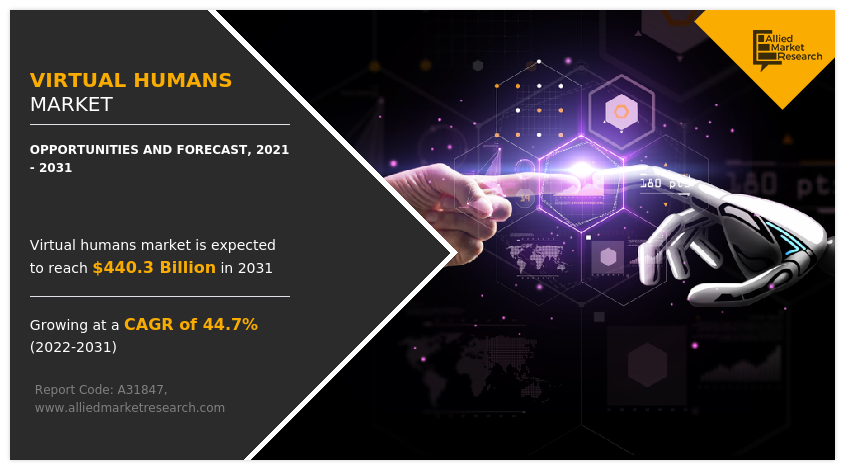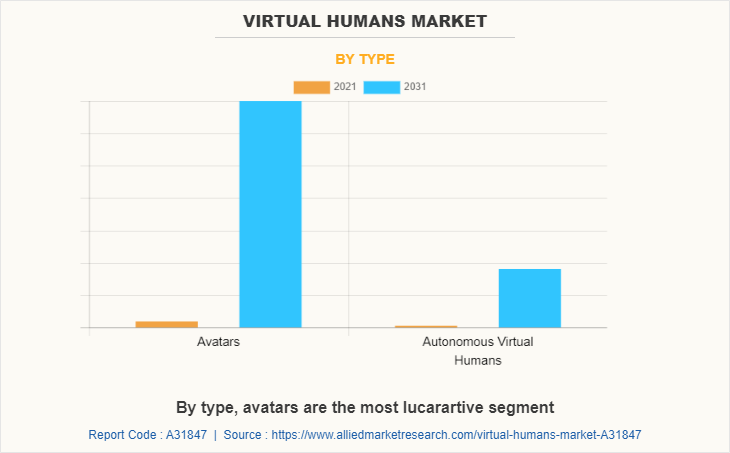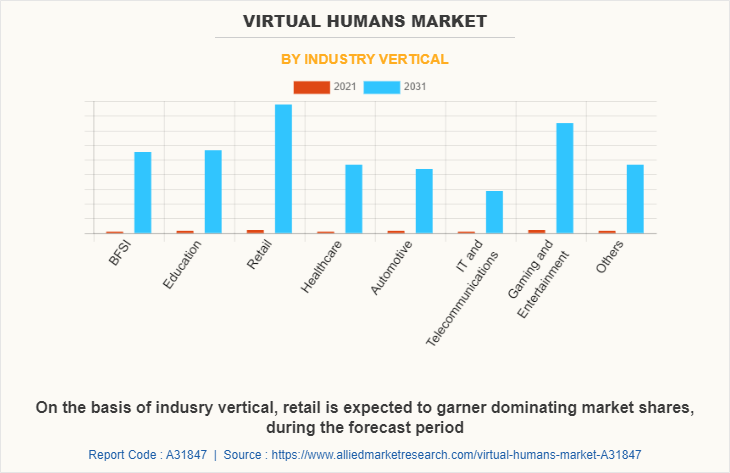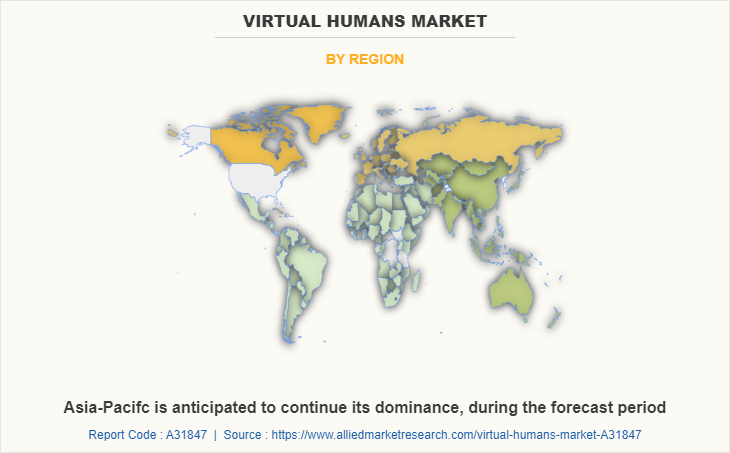Virtual Human Market Statistics: 2031
The global virtual human market size was valued at $11.3 billion in 2021 and is projected to reach $440.3 billion by 2031, growing at a CAGR of 44.7% from 2022 to 2031. Virtual humans may duplicate human motions and facial expressions and communicate via text and audio clips. They are realistic-appearing figures that do a variety of activities. Artificial intelligence allows for the creation of virtual humans with customized appearances, voices, attire, and other similar attributes. Virtual humans serve a variety of purposes beyond education, they may also be used for artistic endeavors. For instance, businesses may employ virtual humans to produce news, films, audiobooks, games, avatars, and various verticals.
Computer representations of actual people are known as virtual or digital humans. Their depiction, mobility, and behavior are the focus of the research domain. These artificially intelligent (AI) figures have been taught to have discussions on relevant subjects. Within interactive simulations, these figures pay attention, speak back, and interact with learners with interactive s. Virtual persons may engage in open conversations with individuals about the subject after receiving training in a particular content area.

The Virtual Human Market is Segmented into Type, Industry Vertical, and Region.
Both the actual world and the virtual world are getting occupied by virtual humans. Companies making make the most of the possibilities of virtual humans in a variety of settings, including healthcare, offices, gaming, and entertainment. End users are currently witnessing the use of virtual humans in the increasingly prevalent virtual realities and metaverses. The avatars are realistic-looking and can copy human reactions, such as squinting in response to bright lighting. Virtual persons are also increasingly being employed in the workplace, to train and develop leadership abilities.
The virtual human market research is segmented into type, industry vertical, and region. On the basis of types, the market is bifurcated into avatars and autonomous virtual human. On the basis of the industry vertical the market is segmented into BFSI, education, retail, healthcare, automotive, IT & telecommunications, gaming & entertainment, and others. On the basis of region, the virtual human market trends are studied across North America (U.S. and Canada), Europe (Germany, Italy, France, Spain, UK, and the Rest of Europe), Asia-Pacific (China, Japan, India, Australia, South Korea, and Rest of Asia-Pacific), and LAMEA (Latin America, Middle East, and Africa). North America, specifically the U.S. and Canada, remains a significant participant in the virtual human industry.

Interactive virtual human avatar are virtual agents, live human agents are more expected to have difficulties creating an interactive environment that takes a personalized approach. Live human agents are taught to answer a standard set of questions. This is created in the way so that virtual agents can instantly adapt to each need of the client and offer a fully unique experience for them. Virtual agents can understand and learn about consumer behavior in real-time. Moreover, virtual human avatars can develop a customized consumer-specific algorithm to understand the patterns of consumer selections and choices in addition to communicating with customers through customized inquiries and responses. Furthermore, companies may use these avatars to train and educate their staff members online, providing lucrative opportunities for virtual human market growth.

Retailers swiftly began incorporating innovative technologies like big data analytics, cloud computing, and digital stores with the change to the internet-related industry. The retail industry has undergone a shift due to major part of digital media as consumers have become more selective about how and when they want to hear from companies. Several significant firms implemented techniques including improving their autonomous virtual humans and working together to adapt to the quickly shifting consumer tastes and effectively handle the large orders of multichannel commerce.
The ideal applications for non-interactive virtual human avatars include promotional and advertising campaigns, displaying virtual human models, and setting up a virtual singing or dancing performance without an audience or site visitors in attendance. For instance, a number of corporations set up 3D virtual events to replicate the actual event-attending experience in a virtual setting. This is accomplished via virtual event platforms like Virtway Events, which provide businesses with the most innovative 3D technology to access the virtual world. There is no need for any machine-to-human (virtual human-to-actual human) exchanges because virtual events are merely watch-and-observe events for the real person. The possibility of such events developing has boosted demand for virtual human market across a range of business sectors.

Across the Asia-Pacific region, shopping malls, grocery stores, supermarkets, convenience stores, and hypermarkets are getting a digital upgrade designed primarily to stay competitive in the next generation of shopping experiences. In countries such as China, India, Japan, South Korea the advent of technological innovations is high as virtual human industry in Asia-Pacific is poised for rapid growth, with applications in sectors such as broadcasting, entertainment, retail, finance, and education. It is also possible that every company eventually will have their own avatar.
In countries such as China India and South Korea several artificial intelligence-powered technologies like natural language understanding, voice interaction and intelligent recommendation have been utilized to create digital avatars. Digital avatars serve as a human-computer interface and are expected to become the fastest-growing industry and a revenue generator in the metaverse in this region. According to the article published by times of India in May 2022, South Korean game companies are increasingly setting their eyes on projects centered on virtual human character development, aimed at carving out new endeavors in non-gaming areas such as music and marketing sponsorships.
Top Impacting Factors
The market for virtual human is anticipated to expand significantly over the course of the forecast period (ML) due to rise in need for virtual space in the metaverse via augmented reality (AR), virtual reality (VR), and machine learning. The virtual human market has grown as a result of the boom in e-commerce and digital retail, as well. The main issue limiting market growth, however, is the absence of technological constraints brought on by the expensive development of intelligent applications and declining labor demand. Contrarily, the rise in machine-to-human consumer connection in a variety of end-use industries and the adoption of intelligent and interactive educational solutions are anticipated to drive the growth of the virtual people market during the projected period.
Growing Demand for Virtual Space in Metaverse through Artificial Intelligence (AR), Virtual Intelligence (VR), and Machine Learning (ML)
During the pandemic the world moved towards greater digitalization across all industries as technology such as the metaverse totally transformed the online world as it enabled its users to meet others by erasing physical distances and using virtual space. The virtual reality technology has been successful in delivering a platform with an immersive experience to the user improving online social interactions and much more beyond social media. Newer commercial and financial growth opportunities are available in the Metaverse as it improves online learning, education, gaming, and the use of cryptocurrencies, non-fungible tokens (NFTs), and the working environment in numerous ways, which in turn boosts the virtual human industry growth.
Major Industry Players
Ke virtual human market players, such as Alibaba Group Holding Limited, Datagen, Epic Games, Inc., iFLYTEK Corporation, Inworld AI, Meta Platforms, Inc., Microsoft Corporation, Offbeat Media Group, Soul Machines and Ziva Dynamics (Unity) are provided in this report.
Key Benefits for Stakeholders
This study comprises an analytical depiction of the virtual human market size along with the current trends and future estimations to depict the imminent investment pockets.
The overall virtual human market analysis is determined to understand the profitable trends to gain a stronger foothold.
The report presents information related to key drivers, restraints, and opportunities with a detailed impact analysis including virtual human market share.
The current virtual human market forecast is quantitatively analyzed from 2021 to 2031 to benchmark financial competency.
Porter’s five forces analysis illustrates the potency of the buyers and suppliers in the virtual humans.
The report includes the market share of key vendors and virtual human market trends.
Virtual Humans Market Report Highlights
| Aspects | Details |
| Market Size By 2031 | USD 440.3 billion |
| Growth Rate | CAGR of 44.7% |
| Forecast period | 2021 - 2031 |
| Report Pages | 178 |
| By Industry Vertical |
|
| By Type |
|
| By Region |
|
| Key Market Players | Ziva Dynamics (Unity), soul machines, Offbeat Media Group, Alibaba Group Holding Limited, Microsoft Corporation, Epic Games, Inc., Meta Platforms, Inc, Inworld AI, iFLYTEK Corporation, Datagen |
Analyst Review
With increasing technology such as machine learning and artificial intelligence virtual humans will play a supporting role in human services work because they cannot only manage multiple inquiries simultaneously but also answer some simple questions. Utilizing virtual humans to the fullest extent possible in everything from hospitals and offices to games and entertainment is expanding along with the frequency of virtual realities and metaverse. The accelerated application of 5G and the research and development of next-generation wireless technology 6G has fueled the virtual human industry as Virtual humans are capable of sophisticated human-like interactions by mimicking genuine body language and facial expressions. Furthermore, different tools and technology such as Machine Learning and Artificial Intelligence help to grow the virtual human market.
The competitive environment in this market is expected to further intensify with an increase in technological innovations, product extensions, and different strategies adopted by key vendors. For instance, in September 2022, the company best known for the battle royale shooter PUBG unveiled what it described as a “hyper-realistic” virtual human Ana, as she’s known, into a virtual star with a brand-new music video. As a virtual influencer, Ana has many hobbies, which include gaming, music, dancing, and fashion. In addition to these interests, her largest motivating factor is spreading joy and happiness through music and entertainment. Ana is more than what meets the eye though, as she wields unexpected powers. She also has a green crystal ring on her finger. The ring itself allows her to teleport to different locations and interact with the world in various ways. In addition to never having to worry about traffic, Ana is also the owner of a “fizz” bubble gun, which gives her the ability to raise the mood and feelings of everybody around her.
Due to an increase in ICT investment, the market for the virtual human market is anticipated to expand significantly over the course of the projected period. The industry has expanded as a result of expanding internet usage and the increased need for virtual humans. For instance, in, May 2022, Facebook parent company Meta’s AI team developed a platform called MyoSuite that creates realistic musculoskeletal models more efficiently than existing ones. Workers can train these models to mimic complex movements such as twirling a pen or rotating a key, helping researchers simulate what would happen after certain surgeries such as tendon transfers. Among the analyzed regions, Asia-Pacific exhibits the highest adoption rate of AI-based services and has been experiencing a massive expansion of the market. On the other hand, North America and Europe are expected to grow at a faster pace, predicting lucrative growth, owing to emerging countries, such as the UK, U.S., Germany, and Canada investing in these technologies. Regions, such as the LAMEA, are also expected to offer new opportunities for virtual humans in the future.
The key players profiled in the report include Alibaba Group Holding Limited, Meta Platforms, Inc, Microsoft Corporation, and Epic Games, Inc. To promote organic growth and solidify their positions in virtual humans, all of these market participants are investing a significant amount into R&D activities. To produce technologically innovative products and acquire a competitive edge in the market, they are also placing a major focus on mergers and acquisitions and strategic alliances. For instance, in August 2021, Inworld AI launched an update in Inworld Studio and created AI characters that can interact via Studio or Quest VR app. Harnessing the timeless storytelling of Alice In Wonderland, the company modeled these characters after common NPC archetypes to spark the imagination. Interactive AI characters with their voices and backstories can provide more natural interaction and deepen in-game immersion. It adapted Wonderland’s classic Victorian personalities for a modern setting and audience, creating AI characters that are memorable from the very first interaction. It provided an opportunity to chat with five characters such as the caterpillar, the white rabbit, the mad hatter, the Cheshire cat, and the queen of hearts.
$440.29 billion is the estimated industry size of virtual humans market.
Metaverse through augmented reality (AR), virtual reality (VR), machine learning (ML), and digital eCommerce transition are the upcoming trends in the virtual humans market.
Retail and customer experience management is the leading applications of the virtual humans market.
Asia-Pacific is the largest regional market for virtual humans.
Loading Table Of Content...


